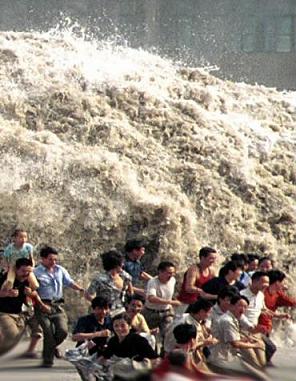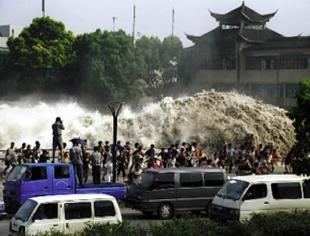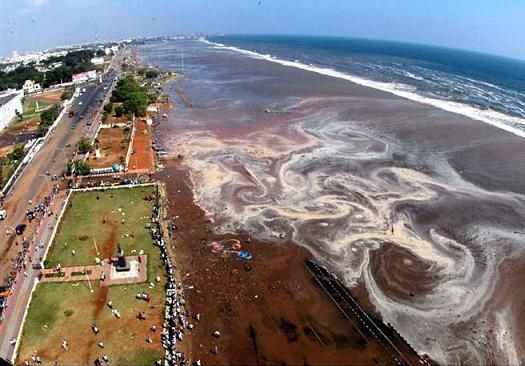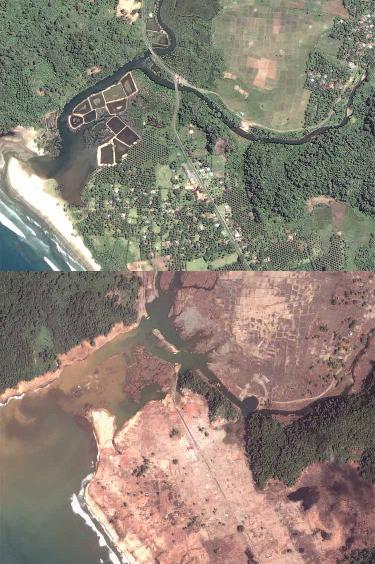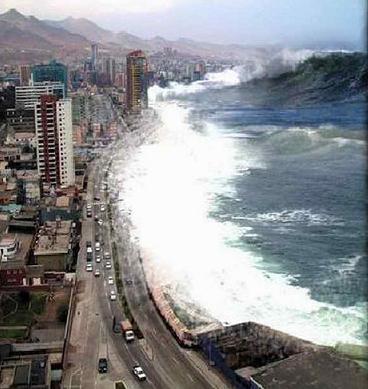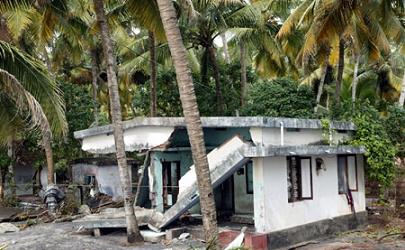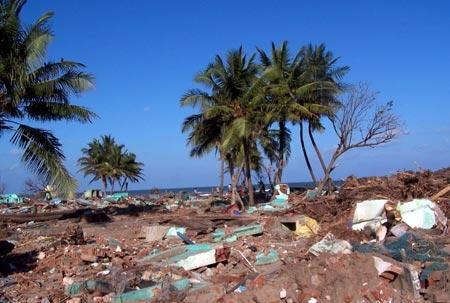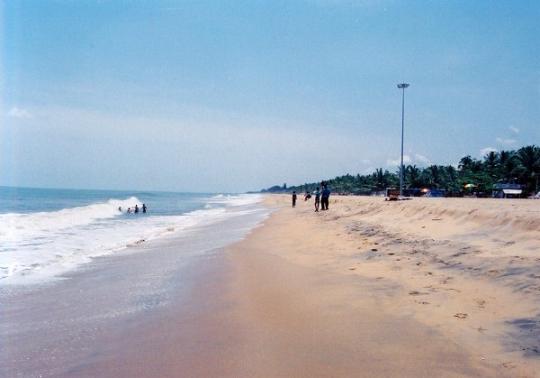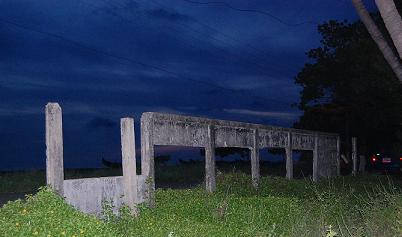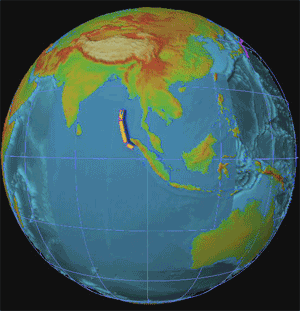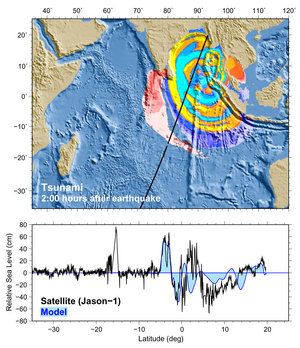|
On 26th December 2004, I was in Kuzhupilly beach near our home with seven friends from Angamaly, a town 50 kms away, enjoying a holiday between Christmas and New Year. At 1pm when I was at home packing beach umbrellas and other things into car, my mother told me that there were TV news about earthquakes, storms etc. at the eastern coast of India. They were the first reports without any mention about tsunami. There was a phone call from my brother residing in Chennai also. I explained Mother that we are in the western coast and need not worry about these storms. In fact, I did not get time to watch TV. I was in a hurry to take my friends to beach. On our way to beach, just 1200 meters from our home, the beach dwellers, mostly fishermen, warned us about possible storms that may hit the shore at any time. They too were ignorant about the killer Tsunami waves. The sea was very calm and there was no wind. The waves have gone noticeably away from the normal position and the beach was just like a foot ball ground with live mussels, seashells and crabs. It was a very strange scene indeed. I suggested others not to go to sea at that time and to wait for some time. Our normal routine was to jump into the waves first and take rest later. We camped beneath the coconut trees just about 20 meters from beach. That place was a beautiful narrow piece of land between sea and backwaters full of coconut trees. From there we could hardly see the sea but hear the slight voice of the exceptionally calm waves. My friends included Janib and Seby who were readers of my email magazine, Monday Mail, since its inception. Others were Wimson, Binu, Jijo, Varghese and Finso. We had a nice time eating, drinking and chatting. They had brought delicious roasted Pork and tapioca from Angamally. I had taken a few prawns cutlets also. Every mobile phone with us was ringing with warnings and enquiries. For a group of men with average age of 30 years, it was not easy to surrender before any challenge. At 2.40 pm we decided to go to beach neglecting all warnings. Seby and Wimson went to beach to take stock of the situation. They returned after five minutes and reported everything was calm and ok. They brought two small sea crabs which they caught from the beach. Suddenly we saw people running towards beach to see something strange happening there. Some fishermen were taking their country boats away from beach. We heard a very loud and strange voice. It was 2.50 pm. Before we can wink our eyes, we saw a huge wave about 50 ft high raised vertically at the beach and smashed the ground very close to the place we were. Faces of Seby and Wimson were turned pale as paper. Had they been at the beach at that time.... we could not think about that. They would probably never forget those two small crabs that saved their lives. All vehicles parked
near beach were covered with sand and water. Huts, small shops, fishing
canoes all were damaged. Luckily, we were in a very safe place. We had
nothing to do but pack everything into the two cars in which we came and
flee from the place. It was very difficult to drive through one feet
of water that covered the road. On our way we saw people running out of
their houses in panic. We took an old lady grasping for breath and another
lady with a 14 days old baby in our car. Some one placed a baby girl in my
lap. She smiled innocently but held my hand tightly. Other car took three
injured men. I do not know how we reached the nearby hospital driving 1200
meters in high speed with the headlights on. We were the first to inform
about the disaster happened at beach to people at main centre. From there,
we managed to send all vehicles available to beach. Almost all people
residing near beach were evacuated within an hour. The tsunami had not
repeated and it was the weakest in our place that caused only 6 deaths
along 25 kms of beach. Kuzhupilly is situated at almost middle of Vypin, 25 kms long and 5 kms average wide, an island having greatest population density in the world. It is very close to Kochi Port (previously Cochin Port). There are historical records showing that the entire Vypin island was raised from sea in the year 1341 AD after a heavy flood. The same flood caused the total destruction of ancient port called Musaris, north of Vypin and the formation of Vypin island facilitated Kochi as a natural sea port. Was it a tsunami that happened in 1341? Who knows? It is very clear that Vypin may not stand a stronger tsunami which may destroy the entire island as happened in Car Nicobar islands. On 27th December at about 10 pm, there was warning in TV and radio that another tsunami is about to hit the shore in one hour. When I saw the news, my mother and younger brother were asleep. And my wife and children were at her house. I kept the volume of TV minimum and decided not to awake mother, aged 77 with an artificial knee joint and my brother, a mentally retarded. However I had to be awake till the ultimatum was over. Suddenly I heard voice of our neighbours at our gate. They thought we all were asleep without knowing the danger. I came out and saw our street full of people. Everyone rushed for safer places in panic. All vehicles were struggling towards north to leave the island as early as possible. When I returned home my mother was watching TV. TV people were showing clippings of tsunami devastation of 26th together with sub-titles that water level started raising in our beach. Many people mistook it as a live telecast. I switched off the TV. Our phone kept on ringing. There were calls from my brother, sisters and other relatives. Everyone asked us to leave the place. Many of our neighbours left the place in panic. Police started announcement asking people near beach to move to safer places. State Transport Corporation had sent buses to our place and many of the private bus operators offered free transportation to people who wished to leave the place. I charged my mobile phone, checked my purse and ATM cards and kept the car key ready. I was ready for any emergency, but did not showed this to my mother and brother and asked them to sleep. It was a sleepless night for me until TV people announced that warning time was over and everything was ok. By God's grace nothing happened. Next havoc was at 11 am on 30th December. I was at Bank. We saw the long line of vehicles going towards Kochi. Later in TV we saw long lines of people leaving the island by foot. Many shops and offices were closed. Our branch near Vypin was closed by noon. There was no customers at Bank. We kept the strong room closed and got ready to meet any emergency. Again, no Tsunami but a marginal hike and fall of sea level. New year was always a time for carnivals and festivities in our beach. This year, all celebrations were cancelled. On 8th January 2005 I visited our beach again with a family came from New Delhi. We found that the place we camped and parked our cars on 26th was the only safe place around. Near the main entry to beach everything was destroyed by the killer wave with in seconds. All huts, boats, bikes, bicycles and small shops in that area were thrown about 10 meters away. Floor of some houses have turned into big trenches. All people who rushed to beach to see the unusual waves were hit badly and injured. I met a man who happened to be the son of the old lady we had taken to hospital on that day. She was in hospital for 5 days and ok now. All people who
stayed in relief camps in main centre for six or seven days had returned
to their houses. While some affected residents, mostly belonging to the
fishermen community, were happy that they had something left to call their
own, others were disappointed and disillusioned about the future. The main
task was cleaning the houses, which were filled with seawater, fish,
seaweeds and sand. It took almost a month to restore normal life at
beach and now life goes on and on just like the waves that rub off
anything we write on the sand.
Cherai Beach, just 3 kms from Kuzhupilly Tsunami effect at Cherai Beach One of my friends
in US posted my tsunami story Check out this
link for amazing video clips (in FLV format) of Largest collection
of Tsunami videos and photos Visit the
following link for 14 sets of Satellite Images Before and After
Tsunami, Help our fellow
brethren by visiting the official web site of
Page designed and
published by
|
